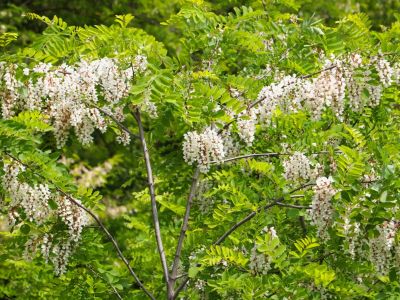The two most common types of locust trees are black locust (Robinia pseudoacacia), also called false acacia, and honey locust (Gleditsia triacanthos) and both types are North American natives. Except for a few thornless honey locust varieties, locust trees have fierce thorns that grow in pairs along the trunk and lower branches. Read on to find out how to grow a locust tree.
Locust Tree Information
Locust trees prefer full sun and tolerate reflected heat from structures. They normally grow quickly, but even a little shade can slow them down. Provide a deep, fertile, moist but well-drained soil. These trees tolerate urban pollution and spray from de-icing salts on roads. They are hardy in USDA plant hardiness zones 4 through 9. Transplant a locust tree in spring in cold areas and spring or fall in mild climates. Keep the tree well-watered and protected from salt spray for the first year. Afterward, it tolerates adverse conditions. Most locust trees produce many thorny suckers over their lifetime. Remove them as soon as they appear. You might think because of their relation to legumes, these trees fix nitrogen to the soil. Well, that isn’t the case for all locust trees. The honey locust is a non-nitrogen producing legume and may require regular annual fertilization with a balanced fertilizer. The other locust tree varieties, especially black locust, do fix nitrogen, thus are not in need of as much, if any, fertilization.
Locust Tree Varieties
There are a few cultivars that perform particularly well in home landscapes. These varieties produce dappled shade under their canopies—ideal conditions for a flower border.
‘Impcole’ is a compact, thornless variety with a dense, rounded canopy. ‘Shademaster’ is a thornless variety with a straight trunk and excellent drought tolerance. It grows more quickly than most varieties. ‘Skycole’ is a pyramidal thornless variety. It doesn’t produce fruit, so there is less fall cleanup.
